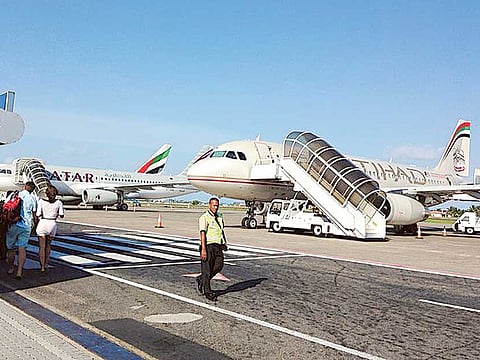Airlines’ fuel bill to drop 25% to $135b in 2016
IATA confident about Mideast airlines’ profitability in coming years

Geneva: With oil prices continuing their slide, the global airlines industry will see fuel bill drop to $135 billion (Dh495.45 billion) next year, representing 20.6 per cent of their total operating costs. This is a 25 per cent drop compared to the $180 billion fuel bill the carriers had to bear in 2015 (comprising 27.4 per cent of operating costs), and a whopping $226 per cent in 2014 (comprising 31.6 per cent of operating costs), according to IATA (International Air Transport Association).
Low oil prices resulting in strong air travel will be key drivers of growth for airlines next year, according to Brian Pearce, IATA’s Chief Economist.
“Consumers benefit from lower oil prices with lower fares, more routes, and spend one per cent of world GDP (gross domestic product) on air travel. There is a lot of surplus oil floating around in the inventories at the moment. Hopefully, fuel costs would be relatively low for the airlines,” he said.
“Jet fuel prices have fallen substantially and we base our forecast on an average price of $63.8 a barrel next year, and $51 per barrel for the Brent crude oil prices. The future price of oil is highly uncertain, with some forecasters expecting $20 per barrel in 2016 while others expect a rise to $60 per barrel.
“Certainly, record oil inventories suggest a significant rise in 2016 is highly unlikely, but expected stronger economic growth should pull prices up from current levels later next year,” he added.
According to the aviation trade body estimates, stronger economic performance in some key economies (including a faster than expected recovery in the Eurozone) is outweighing the overall impact of slower growth in China and the downturn in the Brazilian economy. And the global GDP (gross domestic product) growth, which is expected to improve to 2.7 per cent in 2016, up from 2.5 per cent for 2015, is only expected to make the prospects brighter.
“The aviation industry has strengthened its profitability to an ordinary — not an extraordinary — level. Its profitability is better described as ‘fragile’ than ‘sustainable’,” said Tony Tyler, IATA’s Managing Director and CEO.
Reasonable profit margins for Mideast
The Middle East is, however, split between strong Gulf airlines, with successful long-haul super-connector operations, and regionally-focused airlines, which are suffering from the impact of lower oil revenues and political conflict.
But IATA is confident about profitability of the region’s carriers in the coming year despite the unrest. While the absolute numbers might be less for the airlines in the Middle East compared to other regions, the profit margins are still “reasonable”, Pearce said.
Profit per passenger of $7.97 forecast for 2016 in the region is slightly less than that expected for European airlines and almost a third of what North American airlines are achieving, according to IATA.
Asked if the carriers were likely to lose out on their 2016 revenues due to the ongoing unrest in the region, he told Gulf News: “There are positive aggregates. We are still seeing Gulf carriers doing well with connecting business. While the ongoing social unrest in some markets there has been reflecting in some of the results, the market is poised for growth next year. And there is some very strong growth in Mideast economies.”
Revenues
Revenues are expected to rise by 0.9 per cent to $717 billion in 2016, according to IATA. Industry revenues peaked last year at $758 billion, and then declined to $710 billion in 2015 with the impact of the strengthening of the US dollar on non-dollar revenues.
The increase in revenues next year is expected to be mainly due to the contribution of the passenger side of the business ($525 billion in 2015 rising to $533 billion in 2016), as per IATA estimates. And cargo revenues, meanwhile, are expected to decline slightly to $50.8 billion (from $52.2 billion in 2015).
Demand
With 3.8 billion passengers expected to travel in 2016, the demand for passenger travel is expected to grow by 6.9 per cent (similar to the estimated 6.7 per cent growth for 2015). Passenger capacity, however, is expected to grow slightly ahead of demand at 7.1 per cent in the period.
Load factors
The airlines are likely to end 2015 with record high load factors of 80.6 per cent, tapering slightly to 80.4 per cent in 2016, indicating efficiency gains. Capacity, which is increasing, is expected to move ahead of demand growth in 2016, while yields, meanwhile, continue to deteriorate amid stiff competition, according to IATA.
Sign up for the Daily Briefing
Get the latest news and updates straight to your inbox



